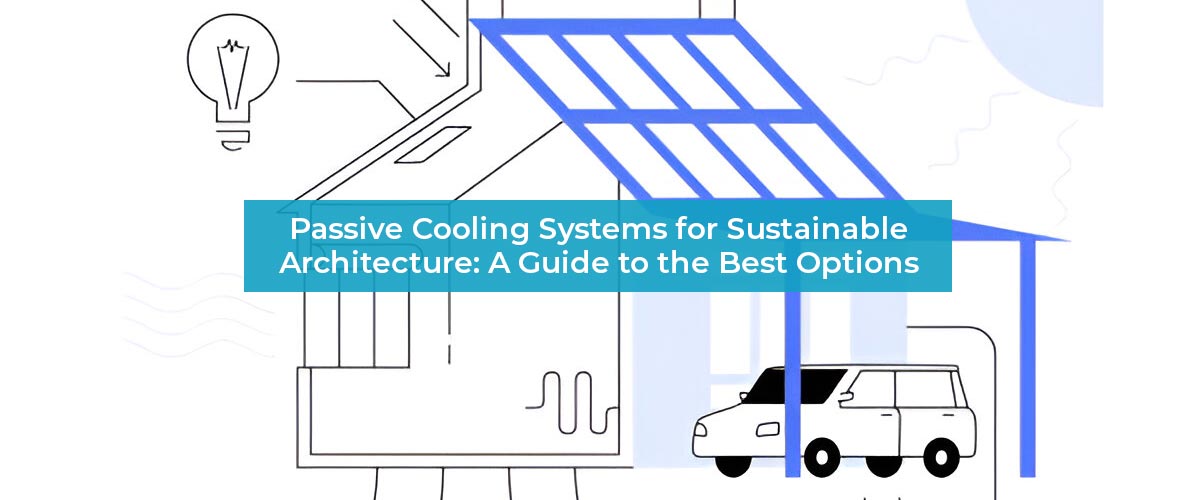In the realm of sustainable architecture, the focus has increasingly shifted towards passive cooling systems as a means to reduce energy consumption and environmental impact. Unlike active cooling systems that rely on mechanical devices like air conditioners, passive cooling utilises natural elements and architectural design strategies to maintain comfortable indoor temperatures. This article explores various passive cooling techniques suitable for sustainable homes and buildings, providing insights into their benefits, applications, and considerations for implementation.
When discussing passive cooling systems in sustainable architecture, gutters play a crucial role that often goes unnoticed. While gutters are primarily associated with directing rainwater away from the building to prevent water damage, their design and placement can significantly contribute to passive cooling strategies. Here’s a detailed exploration of how gutters influence passive cooling and their importance in maintaining a comfortable and energy-efficient indoor environment.
Rainwater Management and Moisture Control
Properly functioning gutters are essential for managing rainwater effectively. By collecting water from the roof and guiding it away from the building through downspouts, gutters prevent water from seeping into walls, foundations, and basements. Excess moisture inside a building can lead to humidity issues, which in turn affect indoor comfort and air quality.
In passive cooling systems, maintaining a dry building envelope is critical. Wet surfaces absorb and store heat, increasing cooling loads during hot weather. By keeping walls and foundations dry, gutters help to minimise heat gain through thermal mass absorption, thereby reducing the need for mechanical cooling.
Understanding Passive Cooling
Passive cooling refers to techniques that harness natural forces such as airflow, thermal mass, and shading to regulate indoor temperatures without the use of mechanical systems. By integrating these strategies into building design, architects and homeowners can achieve thermal comfort while minimising reliance on energy-intensive cooling technologies.
Benefits of Passive Cooling Systems
- Energy Efficiency: By reducing or eliminating the need for mechanical cooling, passive systems significantly lower energy consumption and operational costs.
- Environmental Impact: Decreased reliance on fossil fuels for cooling contributes to lower greenhouse gas emissions and supports sustainability goals.
- Improved Comfort: Passive cooling can enhance indoor air quality and comfort levels by maintaining stable temperatures and reducing humidity.
- Resilience: Passive systems often require minimal maintenance and are less susceptible to breakdowns, offering greater reliability and longevity.
Key Passive Cooling Techniques
- Natural Ventilation:
Natural ventilation leverages prevailing winds and temperature differentials to circulate air throughout a building. Key design considerations include:
- Orientation: Orienting buildings to capture prevailing breezes facilitates natural airflow.
- Cross Ventilation: Designing spaces with openings on opposite sides to encourage airflow.
- Ventilation Pathways: Strategically placed windows, louvres, or vents to facilitate air movement.
- Thermal Mass
Thermal mass involves using materials that absorb and store heat during the day and release it slowly at night. Common materials include concrete, stone, and adobe. Design considerations include:
- Location: Placing thermal mass materials in areas exposed to sunlight during the day.
- Insulation: Ensuring adequate insulation to prevent heat loss or gain.
- Shading
Effective shading reduces solar heat gain and glare, enhancing comfort and reducing cooling loads.
Gutters contribute to shading strategies, particularly when combined with eaves or overhangs. Extending gutters beyond the edge of the roof provides additional shading for windows and walls during the summer months when the sun is higher in the sky. This reduces direct solar heat gain into the building, keeping interior spaces cooler and reducing the workload on cooling systems.
- Eaves and Overhangs: Extending roof eaves to shade windows during peak sun hours.
- Shading Devices: Using pergolas, awnings, or vegetation to provide shade.
In regions like Perth with a Mediterranean climate, where summers can be particularly hot and dry, effective shading is crucial to maintaining indoor comfort without relying heavily on air conditioning. Strategically designed gutters and shading devices work together to block unwanted solar radiation and minimise heat buildup inside the building.
- Cool Roofs and Reflective Surfaces
Reflective roofing materials and surfaces minimise solar heat absorption, reducing cooling demand. Techniques include:
- High-Albedo Roofing: Using materials with high solar reflectance.
- White or Light-Colored Roofing: Painting roofs with reflective coatings.
Implementing Passive Cooling in Perth
In Perth’s climate characterised by hot, dry summers and mild winters, effective passive cooling strategies are essential. Considerations specific to Perth include:
- Solar Orientation: Maximising north-facing windows for winter solar gain while shading west-facing windows to minimise summer heat gain.
- Vegetation: Planting deciduous trees to provide summer shade while allowing winter sun penetration.
- External Shading: Installing external blinds or shutters to block out direct sunlight during the hottest parts of the day.
Choosing WA Gutters Suckers to assist with Passive Cooling
In conclusion, gutters are integral components of passive cooling systems in sustainable architecture. Their role extends beyond rainwater management to include shading, moisture control, and even potential for rainwater harvesting and cooling. By investing in maintaining your gutters with regular gutter cleaning, you can achieve significant energy savings, enhance indoor comfort, and contribute to a more sustainable environment.
Call WA Gutter Suckers today for a free quote on 0475 280 804.


